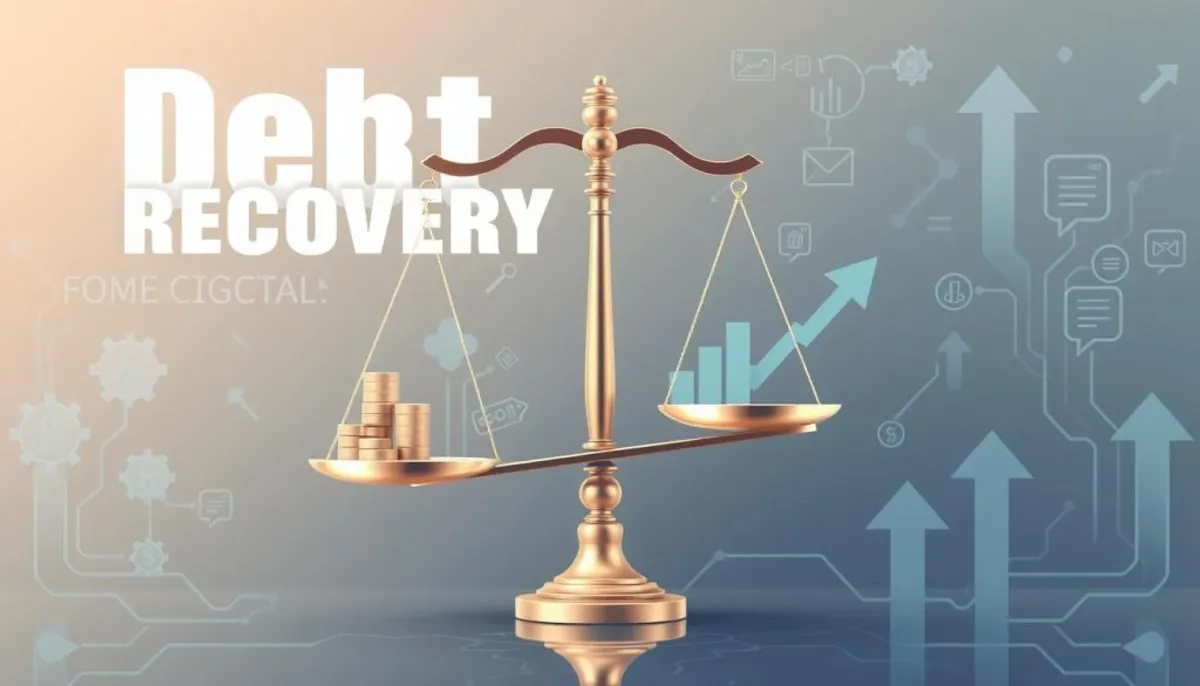In today’s digital age, debt recovery services have evolved significantly. Online collection agencies are transforming accounts receivable management, offering innovative solutions for businesses facing unpaid debts. These digital-first approaches utilize advanced technology to streamline commercial debt collection processes. This ensures maximum efficiency and compliance.

IC System, a nationally recognized debt recovery agency with 85 years of experience, exemplifies this new era of collections. Their customizable programs, such as the two-stage Recovery Plus and the InstiCollect for small businesses, demonstrate how online agencies adapt to diverse client needs. With an average client tenure of 16 years, IC System’s success is rooted in its consumer-friendly approach and commitment to maintaining valued relationships.
The power of digital collection platforms is evident in the impressive results achieved by Virtual Collection Agent, which collects almost $2 billion of debt annually. By automating “Top Agent” behavior online, these systems offer 24-hour coverage, reaching more accounts and boosting online contact rates. This technology-driven approach has led to a 10% reduction in charge-offs and increased payments from late-stage accounts while reducing call center expenses.
Key Takeaways
- Online collection agencies offer efficient debt recovery solutions
- Digital platforms collect billions in debt annually
- Automated systems provide 24/7 coverage and reduce charge-offs
- Consumer-friendly approaches maintain valuable client relationships
- Data-driven strategies enhance collection efforts and compliance
- Customizable programs cater to diverse business needs
Understanding Modern Debt Recovery in the Digital Age
The realm of debt recovery has undergone a significant transformation in recent years. The advent of digital tools and strategies has redefined the approach to managing delinquent accounts. This evolution has introduced both challenges and opportunities for creditors and collection agencies.
The Evolution of Debt Collection
Traditional debt collection methods are losing relevance. Despite 90% of agencies still employing phone calls and letters, digital channels are proving more effective. Email has emerged as the preferred communication method for consumers across all risk categories and balance levels.
Challenges in Contemporary Debt Recovery
Modern debt recovery encounters unique challenges. The constant flux in contact information necessitates the use of skip tracing. Debt negotiation has also become more intricate, requiring advanced communication skills and technological capabilities.
| Traditional Methods | Digital Methods |
|---|---|
| Phone Calls | |
| Letters | Self-Service Portals |
| In-Person Visits | AI-Powered Chat |
The Impact of Technology on Collections
Technology has profoundly impacted debt recovery. Digital platforms facilitate efficient management of delinquent accounts. With 4 in 5 customers resolving debts independently through online portals, innovative payment methods like Apple Pay boast a 93% conversion rate, surpassing traditional options.
Data-driven strategies and automation have significantly increased recovery rates, up to 40%. This digital transformation enhances efficiency and customer relationships, leading to higher satisfaction and loyalty.
Online Collection Agency: The Future of Debt Recovery
The realm of consumer debt collection is undergoing a significant transformation. Digital advancements have reshaped the operations of third-party debt collection agencies, propelling online collection to the forefront of debt recovery.
Digital-First Collection Approaches
Contemporary collection agencies are adopting digital-first methodologies. Given that 95% of the UK populace owns mobile phones since 2015, agencies can now more effectively engage with debtors. This shift resonates with consumer sentiments, as 73% of past-due consumers affirm that digital interfaces simplify bill payments.
Automated Collection Systems
Automation plays a pivotal role in optimizing debt recovery processes. Despite the fact that only 31% of executives have integrated collection technology, its advantages are evident. Automated systems can achieve a 75% success rate in keeping promises and reduce customer complaints by 30%. This efficiency is paramount, given that consumer credit soared to $4.7 trillion in October 2022.
Benefits of Online Collection Solutions
Online collection solutions bring forth several advantages:
- Enhanced debtor communication
- Improved compliance with regulations like CFPB’s Regulation F
- Increased self-service options, catering to 81% of customer demands
- Reduced operational costs through automation
These benefits underscore the transformative impact of online collection agencies on debt litigation and recovery.
Introducing ti3: A Revolutionary Collection Platform
The debt collection industry has seen a profound shift with the emergence of innovative SaaS platforms. ti3 stands out as a pioneering solution, aimed at transforming the way we manage overdue accounts. This platform simplifies the debt recovery process, providing a cost-effective and efficient alternative to traditional methods.
Ti3 employs advanced technology to automate critical aspects of debt collection. Its automated reminders feature ensures timely communication with debtors, enhancing the chances of prompt payments. The platform’s intelligent issue escalation protocols adapt to different debt scenarios, optimizing the recovery process.

ti3’s ability to maintain positive client relationships during the collection process is a notable feature. Unlike third-party debt collectors, ti3 empowers businesses to control customer interactions. This approach preserves valuable connections while achieving better results.
| Feature | Benefit |
|---|---|
| Automated Reminders | Increased payment probability |
| Issue Escalation | Optimized recovery process |
| Client Relationship Management | Preserved customer connections |
| Cost-Effective Solution | Reduced operational expenses |
By adopting ti3, businesses can revolutionize their approach to managing overdue accounts. This innovative SaaS platform is poised to redefine the future of collection agencies, offering a comprehensive solution for modern financial challenges.
Smart Automation in Debt Recovery Process
Debt collection automation is transforming the recovery of outstanding payments for businesses. This cutting-edge method utilizes technology to enhance efficiency and recovery rates. It streamlines processes, making debt collection more effective.
Automated Payment Reminders
Automated payment reminders are a cornerstone of smart automation. These reminders are dispatched via emails, text messages, and phone calls. By implementing a strategic reminder system, businesses can see a 50% improvement in collection rates. This personalized approach ensures timely communication with debtors, increasing the likelihood of prompt payments.
Intelligent Escalation Protocols
Smart automation systems employ intelligent escalation protocols to manage accounts effectively. These protocols analyze debtor behavior and payment history to determine the best course of action. By leveraging AI and machine learning, collection agencies can reduce average handling time by 70% and boost collection rates by 60%. This data-driven approach allows for more targeted and successful debt recovery efforts.
Payment Processing Integration
Integrating payment processing into automated systems simplifies the debt recovery process. This integration enables real-time tracking of payments and reduces errors associated with manual data entry by 40%. Automated systems can handle high volumes of accounts efficiently, ensuring 24/7 coverage and faster processing times. This streamlined approach not only improves cash flow but also enhances overall customer satisfaction.
| Automation Feature | Impact |
|---|---|
| Payment Reminders | 50% improvement in collection rates |
| AI-powered Protocols | 70% reduction in average handling time |
| Integrated Processing | 40% reduction in data entry errors |
By embracing smart automation in debt recovery, businesses can significantly reduce operational costs while improving their collection rates. This technology-driven approach not only streamlines the process but also ensures compliance with legal requirements. It is an essential tool for modern debt collection agencies.
Data-Driven Collection Strategies
In the realm of debt recovery, data-driven strategies have transformed the industry. By employing debt recovery analytics, companies can make informed decisions. This significantly improves their collection processes.
Analytics and Reporting Tools
Advanced analytics tools offer real-time insights into collection efforts. They analyze historical payment patterns to forecast customer behavior. This allows for early intervention in high-risk accounts. For instance, a bank utilizing predictive models witnessed a 20% decrease in write-offs while enhancing customer satisfaction.
Customer Behavior Insights
Understanding customer behavior is vital for effective debt recovery. By segmenting customers based on their preferences and behaviors, collection agencies can customize their approaches. This personalization has resulted in a 30% increase in successful collections for some agencies.
Performance Tracking Metrics
Performance metrics are crucial for evaluating and enhancing collection strategies. Key indicators include:
- Recovery rate
- Average time to collect
- Customer satisfaction scores
- Cost per collection
By monitoring these metrics, agencies can refine their strategies. They focus on high-return accounts and maximize efficiency. This data-driven method not only boosts collection rates but also preserves positive customer relationships during the recovery process.
Maintaining Customer Relationships During Collections
Ethical debt collection practices are essential for preserving customer relationships. Adopting a consumer-friendly approach aids in debt recovery and enhances customer retention. Research indicates that retaining an existing customer is significantly less costly than acquiring a new one. This underscores the critical role of maintaining positive relationships during the collection process.
Effective communication is paramount in debt recovery. Over 30% of communication during collection calls is based on tone of voice and word choice. By using a respectful and empathetic tone, collection agencies can create a more positive experience for customers facing financial challenges.
Tailoring communication methods to different customer demographics enhances the effectiveness of debt collection interactions. For example, younger customers may prefer digital communication channels, while older generations might appreciate phone calls or letters. This personalized approach demonstrates a commitment to customer service and can lead to increased customer satisfaction.
| Aspect | Impact on Customer Relationships |
|---|---|
| Transparent Communication | Builds trust and encourages cooperation |
| Flexible Payment Options | Shows understanding of individual circumstances |
| Empathetic Approach | Reduces stress and fosters goodwill |
| Ongoing Customer Service | Maintains positive relationships post-recovery |
By implementing these strategies, businesses can recover debts while minimizing negative impacts on long-term customer relationships. This approach not only supports ethical debt collection but also contributes to overall customer retention and business success.
Compliance and Security in Digital Collections
Digital debt collection platforms have transformed the industry, introducing new challenges in debt collection compliance, data security, and privacy standards. As technology evolves, so do the regulations governing its use in financial services.
Regulatory Requirements
Debt collectors face a complex regulatory landscape. The Rosenthal Act in California, updated in 2023, prohibits harassment and deceptive practices on digital platforms. This act is among the strictest in consumer protection, setting a high standard for privacy in collections.
Data Protection Measures
Data security is crucial in digital collections. The first fine for PCI non-compliance was issued in 2006, emphasizing the need to protect sensitive financial information. Digital platforms must implement strong security measures to prevent breaches and unauthorized access to consumer data.
Privacy Compliance Standards
Privacy standards in debt collection are rapidly evolving. Digital collection systems must comply with laws like the TCPA to avoid being labeled as spammers. These platforms offer precise control over actions and messages sent to consumers, ensuring they meet regulatory requirements.
| Aspect | Impact on Digital Collections |
|---|---|
| Automated Reminders | Timely, compliant communication |
| Payment Options | Diverse, secure online methods |
| Operational Costs | Reduced through automation |
| Recovery Rates | Potentially higher with data analysis |
| Legal Compliance | Strict adherence to local and international laws |
Digital collection platforms prioritize debt collection compliance, data security, and privacy standards. This approach enables efficient, secure, and legally sound debt recovery solutions. These systems empower consumers to manage their accounts responsibly, protecting their rights and personal information.
Multi-Channel Communication Strategies
Effective omnichannel debt collection necessitates a varied approach to customer communication. The advent of digital outreach has revolutionized the collections field, introducing novel avenues for debtor engagement. This shift caters to diverse age groups and communication preferences.
Diverse generations exhibit distinct communication preferences. Older cohorts often favor traditional methods like letters and phone calls. In contrast, younger demographics gravitate towards digital platforms. Gen X and Millennials, in particular, are adept at navigating multiple communication channels, making them prime targets for a multi-channel strategy.
A successful strategy encompasses a range of touchpoints:
- Email campaigns
- SMS notifications
- Online payment portals
- Live chat support
- Social media outreach
- Traditional phone calls and letters
Utilizing these channels can substantially enhance contact rates and payment collection. For example, online payment portals now account for 15-20% of payments, underscoring the escalating role of digital solutions in debt recovery.
| Communication Channel | Preferred Age Group | Advantages |
|---|---|---|
| Letters/Phone Calls | 75+ years (Traditionalists) | Familiar, personal touch |
| Email/Text | 30-55 years (Gen X, Older Millennials) | Convenient, trackable |
| Chat/Social Media | 0-30 years (Gen Z, Younger Millennials) | Immediate, preferred by digital natives |
Adopting a multi-channel strategy not only broadens reach but also humanizes debt collection. This method enables personalized communication, boosting the chances of successful recoveries while fostering positive customer interactions.
Cost-Effective Debt Recovery Solutions
Digital debt collection has transformed the landscape of business recovery. Through the use of technology, companies can now achieve higher debt recovery ROI. This is made possible by optimizing resources effectively.
Pricing Models and ROI
Modern debt recovery solutions offer flexible pricing models to meet diverse business needs. These models range from flat rates to contingency-based fees. This flexibility allows companies to select the most cost-effective option for their specific circumstances.

Resource Optimization
Digital collection platforms significantly enhance resource optimization. By automating routine tasks, businesses can redirect their workforce towards high-value activities. These activities require human expertise and are crucial for success.
Operational Efficiency Gains
The integration of AI, machine learning, and advanced analytics in debt recovery processes yields substantial gains in operational efficiency. These technologies enable the prioritization of collection efforts, enhance success rates, and streamline the recovery process.
| Feature | Benefit |
|---|---|
| Automation | Reduces manual work, increases speed |
| AI/ML | Improves decision-making, predicts outcomes |
| Analytics | Provides insights, optimizes strategies |
By adopting these cost-effective solutions, businesses can efficiently manage increased case volumes. They can reduce manual processes and achieve better financial outcomes in their debt recovery efforts.
Conclusion
Online debt collection has transformed the management of accounts receivable for businesses. Digital recovery solutions streamline the process, utilizing technology to improve efficiency. This approach not only boosts recovery rates but also fosters positive customer relationships.
The Fair Debt Collection Practices Act (FDCPA) is pivotal in protecting consumers. It mandates that debt collectors follow strict rules, such as contacting individuals only between 8 a.m. and 9 p.m. and limiting calls to seven times within a seven-day span. These regulations ensure fair practices in online debt collection, safeguarding consumer rights.
Businesses that adopt digital recovery solutions gain access to advanced tools for managing debt efficiently. These tools include automated payment reminders and data-driven strategies, optimizing the recovery process. Companies can track performance metrics and gain insights into customer behavior, tailoring their approach for maximum effectiveness.
In conclusion, online debt collection marks the future of accounts receivable management. By embracing digital recovery solutions, businesses can improve their financial health while upholding consumer rights. As the landscape evolves, adopting these technologies will be crucial for staying competitive in efficient debt management.
RelatedRelated articles



